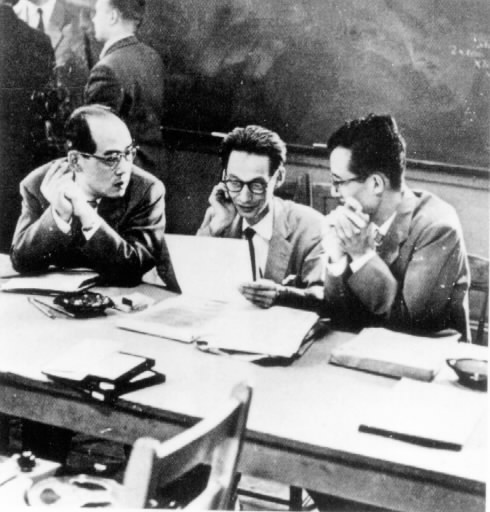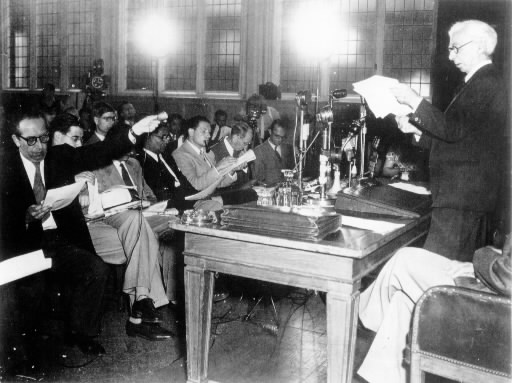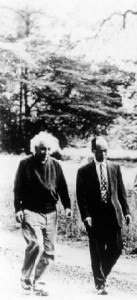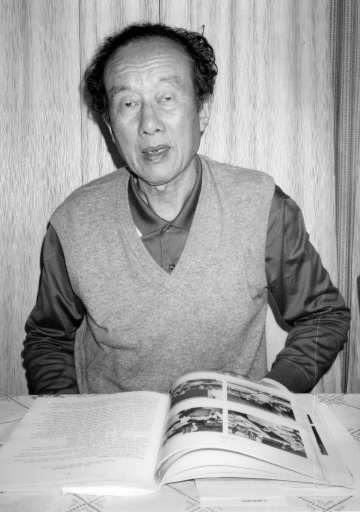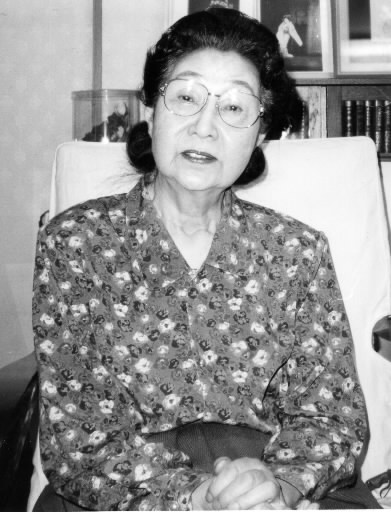History of Hiroshima: 1945-1995 (Part 17, Article 2)
Mar. 8, 2013
Dawn of the Peace Movement II
by Yoshifumi Fukushima, Staff Writer
Note: This article was originally published in 1995.
In the decade following the atomic bombing of Hiroshima, memories of the catastrophe were still fresh in people’s minds. For two-thirds of this period, Japan was under U.S.-led occupation. As a result of the oppression engendered by the occupation, with its deft decrees, the peace movement in Japan arose, led mainly by labor organizations. It was a time of bitter struggle, hardly the dawn of a peace movement. Still, even in those early days, voices in the A-bombed city of Hiroshima did more than utter wishes and prayers, they spoke out against the atomic bombing. This history, which served as a prologue for the subsequent campaigns against A- and H-bombs, should not be forgotten.
Meanwhile, since the end of the war, scientists concerned about the fate of the human race following the advent of atomic and hydrogen bombs, borne of science itself, have sustained their own effort to call into question the context of nuclear power and warfare.
In those early days, the peace movement was heavily tinged with contrition and remorse over the war and the misuse of science as well as a sense of human conscience and an uncontrollable fury against atomic bombs.
Scientists converge in Canada for the first meeting of the Pugwash Conferences
Throughout his life, Dr. Iwao Ogawa has had the book by his side, a book with a blue cover given to him as a memento of his uncle.
As a new student at First High School, he had paid a visit to his uncle seeking advice on the direction of his life. The uncle, a spirited physicist well known for his research into elementary particles, including his influential “theory of mesons,” showed the young man around a research institute investigating the atomic nucleus and lent him the blue-covered book. The book, on the evolution of physics, had been co-authored by Albert Einstein and his uncle. On his way home, the boy became absorbed in reading the illuminating book and made the firm decision, then and there, to pursue the path of physics.
Dr. Ogawa, now 73, is a professor emeritus at Rikkyo University and a resident of Nerima Ward, Tokyo. His maternal uncle was the late Dr. Hideki Yukawa, a Nobel Prize laureate. The eminent book Dr. Yukawa wrote with Albert Einstein, the world’s premier physicist, served to link the two men and, later, Dr. Ogawa. That link, which would grow stronger over the years, led them to take part in peace efforts pursued by the scientific community.
Back in 1957, the village of Pugwash was a poor village located on the east coast of Canada. In early July of that year, Dr. Ogawa took part in an international conference for scientists that was held in this town, a town so small that it did not even appear on a map. For the first forum where scientists from the West and the East discussed the elimination of nuclear weapons and war, three Japanese scientists--Dr. Ogawa, his uncle Dr. Yukawa, and Dr. Shinichiro Tomomaga--traveled across the ocean to Canada.
This was at a time when radioactive contamination was becoming a grave issue as a result of a series of hydrogen bomb tests conducted by the United States and the former Soviet Union. Scientists were concerned and a sense of crisis was rising within the scientific community. Dr. Ogawa, then an associate professor at Rikkyo University who had been engaged in measuring and studying the effects of radioactive fallout, was invited to the conference by Dr. Yukawa and others, who asked him to collect data in Japan and join the delegation.
At a house in the village, the discussions wore on until midnight. Dr. Ogawa took part in these discussions as well, contributing the contamination data from Japan. The debate, which lasted four days, was vigorous, but even-tempered, and the scientists sought to avoid overstating or underestimating the threat of radioactive fallout. This first meeting of the “Pugwash Conferences,” which took on the name of the village, issued a statement which pointed out the damage caused by radiation exposure and appealed for action to halt nuclear testing and rid the world of war itself.
Dr. Ogawa recalled the impassioned mood: “The meeting held a historic significance in that it opened a crack in the wall of the ‘iron curtain’ separating East and West, which had no contact with each other at the time, and enabled the scientists to speak together freely.”
During the discussions, a cassette tape arrived from Bertrand Russell, the British philosopher who was seeking a peaceful path for the world. He said that the conference was not a gathering of representatives of nations, but individuals who had come together purely as a matter of personal conscience. In all, 24 scientists and other figures, from ten nations, took part in the meeting, a small-scale affair. But the conference succeeded in uniting a group of scientists, beyond the borders of nationality, in an examination of their own responsibility in the nuclear age, a time of heightened fears.
It was the “Russell-Einstein Manifesto,” issued two years earlier, that set the stage for the Pugwash Conferences. The statement sounded a warning against the potential annihilation of the human race through nuclear war, and appealed for a ban on nuclear weapons and a halt to waging war. Eleven notable figures, including Nobel Prize-winning scientists from around the world, signed the manifesto. Dr. Yukawa was the lone Japanese citizen to add his signature.
Mr. Russell read out the statement at a news conference in the United Kingdom, cautioning that “we are speaking on this occasion, not as members of this or that nation, continent, or creed, but as human beings, members of the species Man, whose continued existence is in doubt.” Three months before the manifesto was issued, Dr. Einstein passed away. Mr. Russell heard this news aboard an airplane returning from the United States after having consulted with Dr. Einstein about the contents of the manifesto. Dr. Ogawa believes that the manifesto was Albert Einstein’s final message to the world.
Dr. Ogawa has heard Dr. Yukawa’s wife Sumi, 85, a resident of Kyoto, remark many times, “His encounter with Albert Einstein led Hideki to take part in the peace movement.”
In 1948, three years after the war ended, Dr. Yukawa was invited to join the Institute for Advanced Study in Princeton, New Jersey. He was the first Japanese professor at the institute, which brought together scientists from around the world. Dr. Einstein, who had suffered persecution at the hands of the Nazis as a result of his Jewish background, had defected to the United States and was also at the institute then. The white-haired physicist invited Dr. Yukawa and Sumi to his office one day and took their hands as soon as they arrived. He explained that he had advised the U.S. president to develop an atomic bomb out of fear that the Nazis had ambitions for the weapon, but that the bombs then killed and wounded innocent Japanese instead of Hitler, whom he despised. The sight of Albert Einstein offering his tearful apology is still a vivid memory for Sumi.
While Dr. Yukawa and Dr. Einstein were both at the institute, they talked every day, sitting side by side during meals and tea breaks. Their conversations, which Dr. Yukawa shared with Sumi, indicated that the two scientists had gravitated toward the peace movement: “Once a theory has been elucidated, scientists pursue their deeper research. Nuclear weapons, as they stand, will annihilate the human race. Let us envisage a system in which nuclear weapons can be abolished and war is no longer waged.”
As a scientist, Dr. Ogawa grew more deeply involved in the campaign against nuclear weapons after his participation in the first gathering of the Pugwash Conferences. One reason was the admiration he held for his uncle, who had maintained his support for the peace movement. Another reason was his “experience in Hiroshima.”
During the war, Dr. Ogawa, a physics major, graduated from the University of Tokyo earlier than anticipated. Tapped as a technological officer by the Japanese military, he became an instructor in the dynamics department of the Imperial Naval Academy in January of 1944. The academy was located on Etajima Island, not far from the city of Hiroshima. By this time the tide was turning against Japan and Allied air raids against the mainland would soon intensify.
On August 6, 1945, he heard the drone of a B-29 bomber, like the hum of a horsefly. Minutes later, there was a flash of light in the sky, a bluish-purple color. Instinctively, borne of a habit of those trained in physics, Dr. Ogawa measured the time that elapsed following the flash. Some 30 seconds later, there was a powerful blast. When he looked back across the waters of Hiroshima bay, he saw an ominous mushroom cloud rising above the city.
Though Dr. Ogawa had learned about the feasibility of a nuclear fission reaction during his university days, he had no way of knowing that an atomic bomb had actually been developed. However, around August 8, a dozen of his fellow instructors at the academy returned to the island after paying a visit to Hiroshima and observing the destruction firsthand. While they were there, they had heard that surviving X-ray film had turned black. This phenomenon confirmed the speculation that the weapon had been a nuclear bomb. It was a startling conclusion.
“The application of the subject I had set my heart on studying brought about Japan’s defeat in the war and the most appalling catastrophe in history,” thought Dr. Ogawa. It was a severe, confounding shock to the young scientist. He explained that the mushroom cloud, which he witnessed from the island, located about 16 kilometers from the hypocenter, “provided the starting point for me to engage in nuclear issues as a scientist.”
After the war, while working full-time as a lecturer and an associate professor at the University of Tokyo, Dr. Ogawa rushed from place to place to offer lectures on atomic bombs at the request of junior high and high schools in Chiba Prefecture. Although completely apolitical in his presentations, he was nevertheless suspected of being an “anti-American” figure by the U.S. forces then occupying Japan, who ordered that he be shadowed by authorities from the Chiba prefectural government.
In 1972, with the student movement continuing, Dr. Ogawa unveiled a course entitled “Introduction to Nuclear Issues” as part of the educational reform efforts taking place in the liberal arts program at Rikkyo University. In the hope of “conveying the facts about nuclear-related issues to the students, with the aim of rousing public opinion in favor of nuclear abolition,” he continued teaching the course until he retired. In these classes he spoke about the A-bomb damage in Hiroshima and Nagasaki, the effects of radiation, and the state of nuclear disarmament, among other topics. During the 16 years he taught the course, he strove to present a comprehensive vision of the world’s nuclear challenges. Since his retirement, another professor has stepped into Dr. Ogawa’s shoes to teach the course.
The Pugwash Conferences, which began in a lonely village in Canada, have so far convened 44 annual meetings around the world. The gatherings have yielded concrete proposals for the world’s nations, including ideas to warn of the nuclear peril, improve the situation, and ease the standoff between East and West. On the basis of these proposals, negotiations among nations resulted in some significant achievements, among them the Treaty Banning Nuclear Weapon Tests in the Atmosphere, in Outer Space and Under Water, which was signed in 1963, and the Nuclear Non-proliferation Treaty, which was enacted in 1970.
However, some scientists point to a change that has come to the Pugwash Conferences since their inception. They contend that, with each new meeting of the Pugwash Conferences, the number of participating scientists who are engaged in nuclear development activities for the major powers has increased. As a result, the meetings have devolved into technical discussion concerning “arms control.” As the whole notion of arms control is predicated on the existence of nuclear weapons, it runs contrary to the pursuit of real disarmament. Dr. Ogawa stressed: “Even within the Pugwash movement, Japanese scientists have been alone in continuing to criticize the unproductive nature of the nuclear deterrence theory, which seeks to maintain a balance of power through the possession of nuclear weapons.”
Fifty years have now passed since the war ended. Forty years have passed since the “Russell-Einstein Manifesto” was released. In July of this anniversary year, the annual meeting of the Pugwash Conferences will be held in the A-bombed city of Hiroshima, the first Pugwash gathering to take place in Japan.
At this meeting in Hiroshima, the participants should take a fresh look at the state of nuclear weapons in the world, reminding themselves that “though the Cold War is over, now is not the time to feel relieved about the nuclear threat.” Then, returning to the starting point of the Pugwash Conferences, they should explore steps toward the complete elimination of nuclear weapons from the earth.
More than politicians or diplomats, it is the scientists that hold the keenest grasp of the might of nuclear arms. Dr. Yukawa, who passed away 14 years ago at the age of 74, wrote: “As a scientist, I have a responsibility to contemplate the impact of atomic power on humanity more seriously than others.”
On the day Dr. Ogawa and the others made their departure for Canada to attend the first meeting of the Pugwash Conferences, the media had descended upon Tokyo International Airport to cover the appearance of actress Keiko Kishi, who was returning from France. Behind this throng, the scientists quietly set out on their journey.
Today, the world appears, on the surface, to be at peace. Dr. Ogawa also feels some apprehension over the fact that the “Russell-Einstein Manifesto,” which inspired the Pugwash Conferences, may now be perceived as an “old proverb” of sorts. But that statement, which was issued during the Cold War, “continues to live with old and new resonance,” he said. With this conviction, Dr. Ogawa will soon be returning to Hiroshima to take part in another meeting of the Pugwash Conferences.
[Reference] ALBERT EINSTEIN Eine Dokumentarishe Biographie by Carl Seelig
(Originally published on May 14, 1995)

